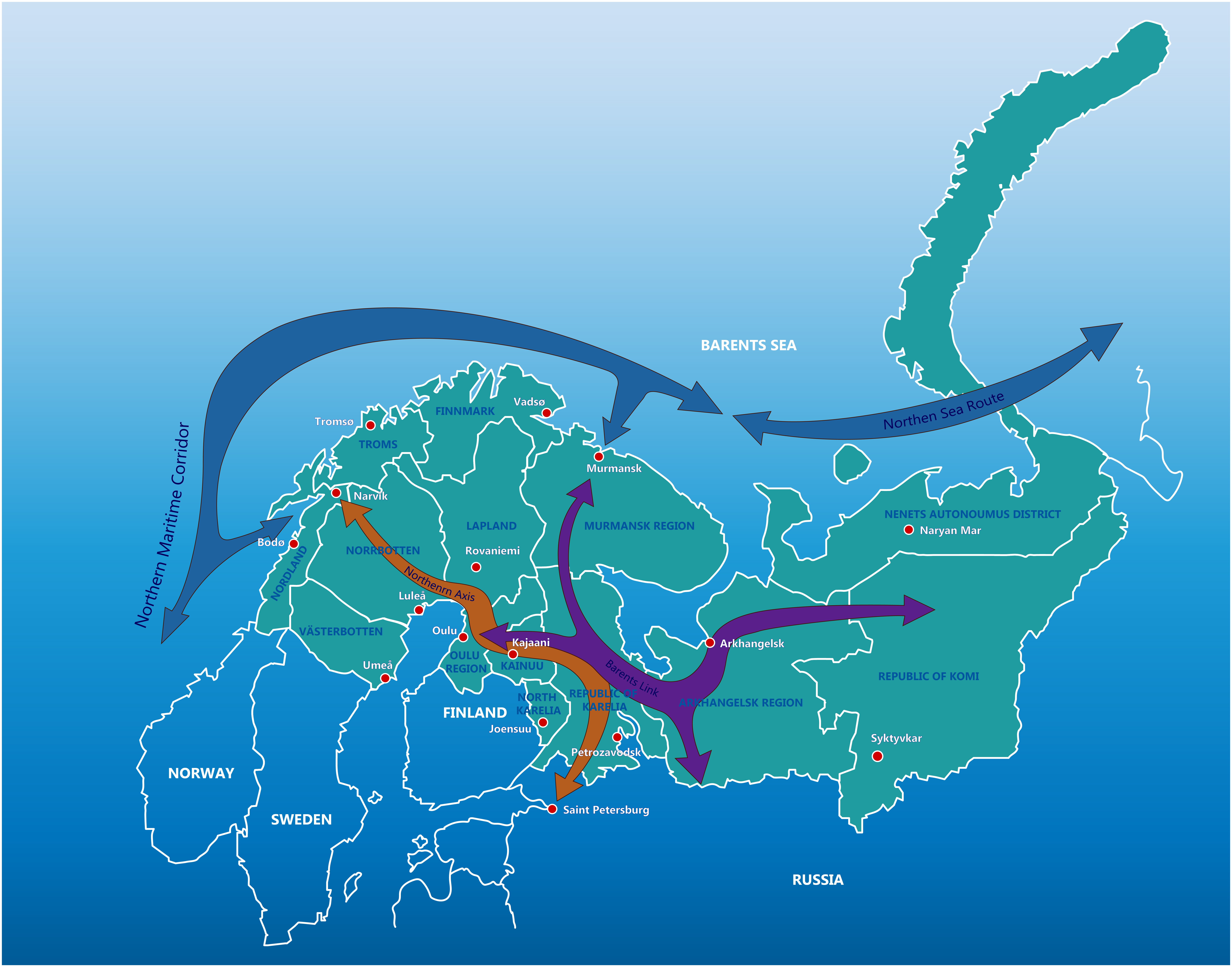The project “Northern Axis – Barents Link” has published a study of the impacts of a new railway connection between Kontiomäki-Taivalkoski-Kemijärvi in Northern Finland. The study was conducted by an expert group formed by Traficon Oy, Ramboll Finland and OOO AvtoDoroshniiConsulting (ADC ltd). The study introduces three railway alternatives, one running via Posio, the other via Kuusamo and Ruka and the third one via Kuusamo-Ruka-Salla. Planning the future connection, many factors are to be taken into consideration.
NABL Project to End Soon
The project “Northern Axis-Barents Link” started in turn of years 2019 and 2020 and is coming to an end in spring 2022. The project has been named after an East-West transport corridor known by the same name. The project is expected to identify the bottlenecks of this northern transport corridor, define the impacts of several initiatives to the east-west transport corridors and networks in the area and to increase understanding of the theme in the project regions.
NABL project has been funded by the Kolarctic CBC programme and ties together multiple partner organisations from northern regions of Finland, Sweden, Norway, and Russia. Regional Council of Kainuu acts as the lead partner.
Kainuu is a part of Barents cooperation structures, and also the NABL project has a clear connection to the broader Barents Euro-arctic transport cooperation. The work packages of NABL Project Action Plan also contribute to the Joint Barents Transport Plan (JBTP) implementation by developing evaluation instruments, infrastructure solutions and creating materials for further research work.

Three Alternative Routes for Kontiomäki-Kemijärvi Railway
The study of Kontiomäki-Kemijärvi Railway is a part of the NABL project Work Package 6 and was conducted on the assignment of the Local Federation of East Lapland. The Local Federation of East Lapland (Itä-Lapin kuntayhtymä) is leading two tasks in NABL. One of those is to study the impacts of a new railway connection between Kontiomäki-Taivalkoski-Kemijärvi.
The study was conducted by Traficon Oy, Ramboll Finland and OOO AvtoDoroshniiConsulting (ADC ltd). The project manager was engineer Juha Hyvärinen from Traficon Oy. Ramboll ’s consultants were engineer Hannele Vartia, M.Sc Jyrki Rinta-Piirto, M.Eng Juha Riihiranta and M.Sc Atte Riihelä. ADC’s consultant was Elena Svatkova.
The alternative routes were studied, cost estimates for the routes were made, potential amounts of passenger and freight transport were estimated, and passenger demand for the whole railway connection for several alternatives were assessed (modeled). In addition, the conformity of the railway route options with the current land use and the land use plans, as well as the potential effects of the implementation, were also assessed.
The railway line shown on the following map starts from Kontiomäki in Paltamo, following the current rail line to Pesiökylä in Suomussalmi. A decision has already been made on improving this railway section between Kontiomäki and Pesiökylä, and € 81 million has been set aside for that purpose in the state budget. Renovation of the track is currently underway. Between Pesiökylä and Taivalkoski, the route follows the alignment of a railway that has been closed from traffic.

During the first stage, two options were studied for the route Taivalkoski-Kemijärvi, with an accuracy that corresponds to the level required for the survey of the regional plan directive marks. One of the routes is as straight as possible and runs via Posio (1b). The second route option (2a) runs via Kuusamo and Ruka. At the meeting of the Local Federation of East Lapland (Itä-Lapin kuntayhtymä) on 6th October 2020, the decision was made to include also a third option, running via Kuusamo, Ruka and Salla (2b). According to the following meeting of 8th December 2020, all the three route options needed to be included, as further studies (cost estimates etc.) were to take place.
The study also includes the aspect of combining the Kontiomäki-Kemijärvi railway plans to the two continuing Arctic Ocean (Salla – Kantalahti – Murmansk and Rovaniemi-Kemijärvi – Kirkenes). For example, the cost estimates have been done and the passenger demand has been assessed (modeled).
Freight traffic volume analyses were left out of the survey, because the model was closed down on 31.12.2019. The following similar freight model (produced by Traficom) will be available no earlier than in 2026. On the northern lines studied with the model before, the benefits of freight transport have accounted for at least 80% of all the economic benefits. In the absence of this freight traffic model, it wasn’t possible to make the socioeconomic calculations in this context, either. The freight traffic volumes of the new rail option are affected by e.g. the volume of timber transports, the implementation of the Sokli mining project, and the development of the Salla-Kantalahti rail line.
Quite a Many Aspects Affect Planning
The potential terrain corridors were studied in relation to the regional land use plans, general land use plans (master plans), urban areas, protected areas as well as in relation to the areas with permits for ore prospecting and the applications and the reindeer herding areas. The most significant negative effects of the railway project were estimated to be on reindeer husbandry, as pasture areas are divided and shrinking, traffic may impede animal movement and the risk of reindeer collisions may increase.
Regarding the three railway options between Taivalkoski and Kemijärvi, the implementation costs were studied at two different design speeds: 100 km / h and 200 km / h. At higher design speed, it is more difficult to avoid obstacles (e.g. high hills), the embankments and cuts will inevitably turn out high and tunnels as well as bridges long. Example of tunnels and bridges at 200 km / h:
- Alternative 1b (via Posio) includes 17 tunnels, with a total length of 18,4 km and 59 bridges
- Alternative 2a (via Kuusamo and Ruka) includes 19 tunnels, with a total length of 31,8 km and 86 bridges
- Alternative 2b (via Kuusamo, Ruka and Salla) includes 13 tunnels, with a total length of 22,9 km and 79 bridges.
A design speed of 100 km/h would reduce the number of bridges and tunnels significantly. It is estimated that a lower speed would reduce the number of tunnels by 70%. In addition, the bridges can also be shorter in length, and about 30% of the wetland overruns can be avoided.
In all alternatives this new railway connection would form a new alternative North – South (night train) passenger transport route to current Helsinki – Rovaniemi – Kemijärvi route. The annual passenger traffic forecast for year 2040 for option (1b) aligned via Posio is 105,000 passengers between Kontiomäki and Taivalkoski and 75,000 passengers between Taivalkoski and Kemijärvi. The corresponding figures for option 2a (via Kuusamo) are: between Kontiomäki – Kuusamo 135,000 passengers and between Kuusamo and Kemijärvi 80,000 passengers. The passenger traffic forecast for option 2b between Kontiomäki and Kuusamo is 140,000 passengers, between Kuusamo and Salla 90,000 passengers and between Salla and Kemijärvi 80,000 passengers in 2040.
Based on the study, it is proposed that all three line alignment options should be considered in the regional land use plans.


